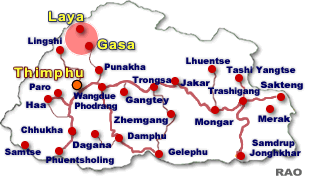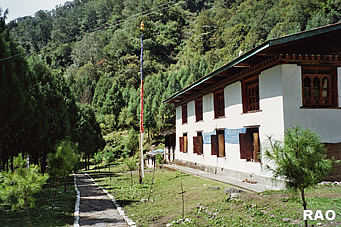| The
healing waters of Gasa - Gasa Hot Springs |
 |
Bhutan's
Tourism: Festivals |
|
 |
Bhutan Information |
|
|
 |
| Gasa
Tshachhu |
 |
 |
Gasa
dzongkhag is famous for its hot springs (tshachhu) known for
their healing powers. In fact it's about the only attraction the country's
remotest and poorest district can boast of.
Located
about two hours walk down hill from the dzong, beside the Mo chhu,
Gasa tshachhu is believed to cure rheumatism, arthritis, ulcers, indigestion,
skin diseases, even tuberculosis and other ailments. Results come if one
soaks for more days. |
|
The healing
water attracts more than 7,000 visitors a year, most visit the hot
springs in winter. Bhutanese, old and young, from far and near, with weeks'
rations, converge at the Gasa tshachhu to seek the curative powers. The
few houses around the tshachhu are occupied to the full and many pitch
tents that sometimes number as much as 60. Some visitors stay for months.
Experts say that the tshachhu is rich in sodium, potassium, calcium chloride
and several other minerals.
 |
| On
a typical wintry morning, long lines of people queue up outside the tshachhu
ponds waiting for their turn. The collective sound from the recitation
of prayers and bazagurus from inside the ponds climb several notches along
with the chatter and the banter.
Winter
draws more people for several reasons. Firstly it is believed that the
water has stronger curative powers in the colder months, secondly one can
soak for several more hours than in summer and thirdly the two day walk
from Tashithang is free from rain and leeches. |
|
Gasa
tshachhu (Gasa Hot Spring) has four main ponds of about three feet deep, of concrete
and rock, all roofed, and each meant for different ailments. One pond can
hold about 12 people each. There is also a pond to wash up before dipping.
Regular visitors say that the Gasa tshachhu is cleaner than before. There
are several toilets. In the past, visitors relieved themselves in the open
and farmers brought domestic animals - pigs, horses and cows to the tshachhu
for broken joints and other ailments. Animals are now banned from the tshachhu.
top
| Menchhu |
 |
Next
to the hot spring is the mineral spring water (menchhu) that is
valued for its curative properties. Above the Gasa tshachhu is a mineral
spring inside a small cave which is believed to cure sinus if a person
puts his head inside and inhales the air for a prolonged period. Five hours
walk to the west of the tshachhu is the ackay menchhu which heals boils
and other sores on the body. There is also biagyet menchhu for tuberculosis.
The
Gasa tshachhu is a popular stopping point for travellers as well. Trekking
companies make sure that tourists enjoy the tshachhu. Japanese love it,
if not for its medicinal value, for its warmth and therapeutic comfort.
Visitors believe the thermal springs are great for relieving stress and
tension too.
Traditional
medicine doctors (Dungtshos) in Thimphu, though, say that it is not
good for people with high blood pressure, eye and dizziness disease, and
with heart ailments.
Gasa
tshachhu's historical records are sketchy at best as it is for numerous
other tshachhus in the country. Dungtsho Yeshey Dorji of the institute
of traditional medicine services says that the country's ancient traditional
medicine doctors discovered the medicinal values of the tshachhus and spread
the discovery.
Because
of their curative powers tshachhus were held sacred by the Bhutanese, many
believing them to have been touched by divine hands. It is said that Bhutanese
warriors wounded in battles sought tshachhus to soak in and applied the
warm mud as salve for wounds. Sometimes they travelled for weeks to bathe
their wounds in the water. Traditional medicine doctors have long since
been prescribing the healing waters for their patients.
Some
of the most famous tshachhus are Dur in Bumthang hidden in the mountains
and accessible after about four days walk, Nye in Kurtoe, Koma and Chuphu
in Punakha and Dunbang in Zhemgang. They are all difficult to reach
and entail more than a day's walk through the rugged terrain.
The
Gasa tshachhu is more accessible than the others. The people of Gasa have
not been blind to take that advantage and over the years small scale economic
activities have sprung up around the hot springs. Shops have come up, farmers
sell vegetables and other edibles to visitors including tourists and most
hire their ponies to transport people and goods. For a dzongkhag with no
electricity or road in any of its four geogs and has yet to catch up with
the rest of Bhutan, this is small comfort although it has helped bring
smiles and income to a few farmers.
With
donations from the government and the donors, the dzongkhag has renovated
the single guest house (visitors pay Nu 5 to Nu 20 a night), built river
retaining walls and toilets, improved the water supply, and generally tried
to keep the place clean. Gasa Dzongda Chencho Tshering said that
the user fee for the tshachhu has also been increased to Nu 20 an individual.
"The idea is to sustain the tshachhu so that it need not depend on the
government for funds," he said. There are plans to build more guest houses
in the future.
With
the road to reach Damji from Tashithang this year and proposals of the
next 25 kilometres to be built to reach Gasa in a few years time, Gasa
tshachhu would soon find itself bombarded by visitors, especially town
dwellers, a proposition the locals are anxious about.
People
doubt if tshachhus such as Gasa's would ever find a niche in the larger
scheme of economics, especially in tourism. Tourism officials, however,
maintain that it features as a by product in the "wellness segment" of
the traditional medicine and spa package to be sold in the future to tourists.
It's uncertain when that would be.
Observers
also speculate if with modernisation tshachhus would retain their magic
for long. In the west hot springs lost out to modern medications which
held out the promise for rapid cures of many chronic diseases, which seemed
more attractive than several weeks of bathing and other water-related treatments.
Physicians were also not all convinced of their medicinal value mainly
because no scientific proof existed.
But
for elderly Bhutanese like Ap Lhap Tshering, 81, from Lhuentse, a regular
visitor to Gasa tshachhu, the magic will never wane. "It's nature's way
of healing people."
 |
| Contributed
by Kencho Wangdi, KUENSEL, Bhutan's National Newspaper |
| Information on Bhutan |
 |
|




